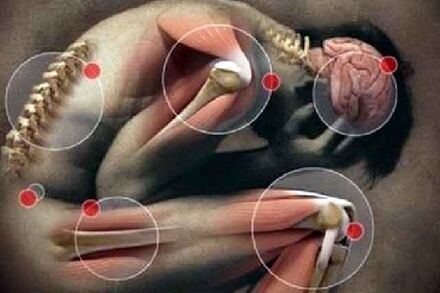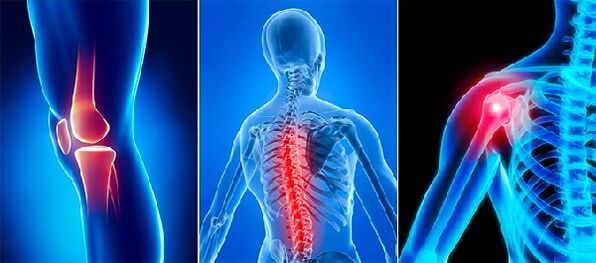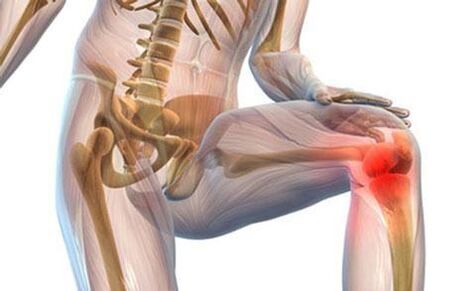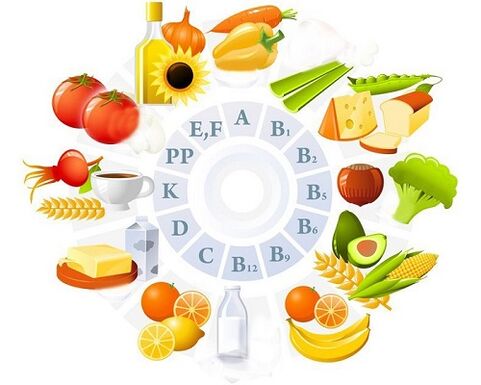Osteoarthritis is a chronic joint disease, accompanied by pathological changes in the hyalink norpel and then in adjacent tissues, a joint capsule and a synovial bowl.
The defeat is dystrophic and degenerative nature, which leads to a change in the structure of joint tissues and the loss of its functionality.According to the data of the same statistics, osteoarthritis is subject to 12% of the total population of the planet.From 62% to 65% of all disease episodes, people over 60 years fall.
Another 30-35% of the cases of joint damage to this pathology are in patients between the ages of 40 and 60.And about 3% are young people between the ages of 20 and 40.
What is that?
In simple words, osteoarthritis is a chronic disease in which degenerative-dystrophic changes develop in the joint due to a violation of metabolic processes.It is the most common common pathology and is diagnosed in 6-7% of the population.The incidence increases dramatically with age.
Most of the time, with osteoarthritis, small joints of the brush are involved in the pathological process (ten times more often in women than in men), the thumb of the foot, the bandwidth of the chest and cervical spine as well as the knee and hip joints.The osteoarthritis of the knee and hip joints sees a foreground in relation to the severity of clinical manifestations and a negative impact on the quality of life.
Arthrosis is characterized by comprehensive damage to the articular and auxiliary devices:
- Chondritis - inflammatory changes in the cartilage of the joint;
- Osteitis - participation in the pathological process of subject bone structures;
- Synovitis - inflammation of the inner shell of the joint capsule;
- Burit - Defeat of the Perioseman bags;
- Reactive inflammation of the soft tissue (muscles, subcutaneous fiber, band apparatus), which are in the projection of the joint (periartic inflammation).
The disease is determined in 2%of people under the age of 45 after 30%of 45 to 64 years and 65-85%from 65 years.The greatest clinical importance due to their negative effects on the standard of living and the ability of the patients are osteoarthritis of large and medium -sized joints of the limbs.
Types of osteoarthritis
Depending on the cause of the pathological process, primary arthrosis is secondarily and idiopathically differentiated in the joint.
The primary is developed as a independent disease due to an injury or infection, and the cause of the idiopathic form is not known.In addition to the classification of the disease, a distinction is made between the cause of the pathological process arthrosis at the location of the localization of destructive changes:
- Gonarthrosis is the most common type of pathology characterized by damage to the knee gene.Most of the time, gonarthrosis is determined in people with excess weight with chronic metabolic diseases in the body and weak immunity.The knee arthrosis runs for a long time and gradually leads to a complete loss of the motor function.
- The arthrosis of the shoulder joint is the main cause of degenerative processes in this area.
- The ankle arthrosis - the main causes for the development of degenerative processes in the ankle joint are injuries, transfers, stretching, fractures.In some cases, the development of the pathological process can provoke an autoimmune disease - rheumatoid arthritis.The ankle arthrosis is susceptible to dancers, women who wear high heels, athletes.
- Exposed or arthrosis of the cervical region - causes are neck injuries, progressive osteochondrosis, obesity and inactive lifestyle.People who work on the computer are danger in offices.In addition to severe pain in the neck, patients have spoken dizziness, consciousness, memory disorder and tiredness.These symptoms are due to the compression of the vertebral artery through which nutrients and oxygen get into the brain.
- Coksart rose or arthrosis of the hip joint - the main cause of the appearance is age -related changes in the tissue of the joint.Endangered, people over 45 years old.
- Osteoarthrosis of the fingers - develops for the same reason as spondy arthrosis.
- Polyrthrosis - characterized by damage to several joints with progressive degenerative processes, while ligaments, muscles and tissue accumulators are involved in the pathological process.
- Spondylarthrosis - The destructive destruction is subject to tissues of the spine, namely the lumbar department.A woman's risk group during menopause, since spondylarthrosis progresses against the background of a lack of female sex hormones.

The causes of osteoarthritis
The formation of osteoarthritis is facilitated by two causes - the stress and the lack of a full diet, which provides vitamins and minerals to restore the tissue.The joints of every person bear a load.The athletes and dancers with physical work are the load on the feet larger, which means that bone joints wear out faster and require a high diet.With a calm lifestyle, the support apparatus deteriorates more slowly, but also requires regular renewal of the fabrics.
Therefore, the main condition for the destruction and deformation of the joints is an inferior diet that does not disassemble useful components, which occurs frequently in metabolic disorders.
We list the factors that contribute to wearing the joint connections and metabolic disorders:
- Muscle weakness and improper stress on the joints.The weakening of one or the muscles increases the load on the joint and distributes it unevenly within the bone connection.A false muscle pollution is also formed at flat feet, so these "harmless" diseases appear with the age at which cartilage tissue wear, osteoarthritis.
The likelihood of osteoarthritis increases with strong physical exertion.
When the daily loads exceed the skills of bone tissue, microtraumas are formed in them.Sicking arises from injury points that grow over time and deform the joint.
- Metabolic disorders (stomach -intestine disease - stagnation of bile, dysbiosis, gastritis, cholecystitis, pancreatitis, metabolic disease - diabetes);
- Psychosomatic causes - The psychosomatics of osteoarthritis confirms that the cause of the disease becomes a negative emotional state.Stress forms muscle cramp, constant stress disturbs the diet of all tissues (internal organs, bones, joints);
- Inheritance (the type of metabolism is inherited and its possible violations, a tendency towards muscle weakness or the wrong formation of the bone apparatus, for poor digestion - which is the basis for the development of osteoarthritis in old age).
Arthrosis is a disease of worn joints that lost a significant supply of minerals and the ability to counteract loads and destruction.Therefore, with increasing age, the disposition increases to the disease.After 70 years, every second pensioner is diagnosed with osteoarthritis.Since the maximum load falls on the feet (one person moves - walks, stands, runs, jumps), the first signs of osteoarthritis are formed.
The mechanism of progression of the disease
If one of the causes that provoke the disease of the joint with osteoarthritis occurs, pathological processes begin to develop.The mechanism of its progress is not completely investigated, but the main stages of official medicine are known.
In the initial phase, the structure of the cartilage tissue and abnormal changes in the synovial fluid occurs.All of this is due to violations of metabolic processes, in which common tissue does not receive the necessary components in sufficient quantities or withdrawn by some of them.
Next, the elasticity of collagen fibers and the flexibility of the cartilage is lost, since hyaluronic acid with lack of nutrients has no time to create the softness and flexibility of the structural composition of collagen fibers.The cartilage gradually dries, becomes brittle and crack.The liquid in the synovial capsule is gradually exhausted and then completely disappears.
Fixed bone -noplasms are formed on the cartilage tissue.At the same time, the deformation of other articular tissue, its pathological degeneration, dystrophy and the loss of physiological activity is developing.For the patient, these changes mean the occurrence of pain, lameness and immobility of the joint.
Symptoms of arthrosis
Osteoarthritis is not characterized by an acute clinical picture.Changes in the joints are progressive and grow slowly, which is manifested by a gradual increase in symptoms:
- Pain;
- regular crunch in the affected joint;
- Joint deformation that appears and improves in the course of the disease;
- Stiffness;
- Restriction of mobility (reduction in the volume of active and passive movements in the affected joint)
The pain in arthrosis is stupid transient and occur against the background of an intensive stress at the end of the day (it can be so intense that the patient cannot fall asleep).The constant, non -standing nature of arthrosis is uncharacteristic and indicates the presence of active inflammation (subchondral bones, synovial membrane, band apparatus or periartic muscles).
Most patients found the presence of the starting pain mentioned in this way, which occur in the morning after waking up or after a long period of inactivity and overturn during motor activity.Many patients define this disease as the need to develop a joint or "disperse".
Arthrosis is characterized by morning stiffness, which has a clear localization and is at short notice (no more than 30 minutes).Sometimes it is perceived by patients as a "feeling of jelly" in the joints.Maybe a feeling of jam, stiffness.

The main symptoms of arthrosis combine with the development of reactive synovitis:
- Pain and local temperature increase, determined by palpation of the affected joint;
- constant nature of pain;
- Increased volume connection, swelling of the soft tissues;
- Progressive reduction of the movement volume.
Stages and degrees of arthrosis
During the disease, medicine distinguishes three stadiums, the differences in the signs of the disease, the intensity of damage and localization.At the same time, the differences in all three phases refer to the types of fabrics that are subject to pathological changes.
- The first degree of development of the arthrosis of the joints is the initial phase of the disease.It is characterized by a slight lesion of cartilage tissue and the loss of physiological functions in collagen fibers.At the same time, minor morphological diseases of the bone tissue and structural changes in the synovial fluid are found in the first stage.The cartilage of the joint is covered with cracks, the patient has a slight pain instead of the localization of the pathology.
- The second degree is the development of osteoarthritis with an increase in dynamics.This stage is characterized by the occurrence of stable pain, chroma.Remarkable morphological and dystrophic cartilage cartridges are found that bone growth showed during the diagnosis.Osteophytes are formed - bone growth that are visible during a visual examination of the destruction point.At the same time, the processes of degenerative changes occur in the synovial capsule, which leads to its structural exhaustion.The disease in this phase can often worse and be regular.The pain gradually becomes constant.
- The third degree is an active progression.Due to its degeneration, the synovial fluid is almost complete and bone tissue around each other.The joint mobility is almost completely missing, the pain becomes more tangible.Cartilage tissue also lacks degenerative and atrophic changes.The treatment of the third arthrosis degree of joints is considered impractical.
In addition to these three degrees of development in pathology, there is a final phase - irrevocable destruction of all common tissue.In this phase, it is not only impossible to carry out productive therapy, but also to remove pain syndrome.
The inflammatory process usually begins with a second degree of damage in rare cases in the absence of medical interventions in the first stage.Afterwards it becomes more difficult to stop it, and this can lead to secondary pathologies, the development of a pathogenic microflora is developing instead of the localization of the disease.
In order to rule out serious consequences, the treatment from the first degree and the use of intensive care methods should begin.In the last stage associated with the complete destruction of cartilage tissue, only a methodology for riding the patient from pain and the immobility of the joint is permitted - endoprosthetics with complete or partial replacement of the components of the joint.
Consequences
The consequences of early treatment and the introduction of the arthrosis of the joints are with complications such as:
- Disability;
- Deformation without the possibility of recovery;
- the occurrence of vertebrates;
- an inactivity or immobility of the joint;
- Reduction of quality and living standards.
The chronic course is accompanied in addition to these complications of intensive and frequent pain, the complete destruction of the structural components of the joint, the symptoms, the inability, physical work and sport.
Diagnosis
The diagnosis of osteoarthritis is based on the evaluation of anamnestic data, characteristic manifestations of the disease, the results of instrumental research methods.Indicative changes in general and biochemical blood tests for arthrosis are not characteristic, they only appear with the development of an active inflammatory process.
The most important instrumental method for diagnosis of osteoarthritis is radiography, in diagnostically unclear cases a calculated or magnetic rejection imaging is recommended.
The osteoarthritis of the knee and hip joints sees a foreground in relation to the severity of clinical manifestations and a negative impact on the quality of life.
Additional diagnostic methods:
- Atraumatic arthroscopy;
- Ultrasound (evaluation of the thickness of the articular cartilage, synovial bowl, condition of the joint bags, the presence of liquid);
- Scintigraphy (evaluation of the bone tissue of bones that form the connection).
How do you treat osteoarthritis?
It is better to treat the arthrosis of the joints in an early stage, the treatment itself should be pathogenetic and complex.Its essence is to eliminate the causes that contribute to the development of this disease.It is also necessary to eliminate inflammatory changes and to restore the previously lost functions.
The treatment of osteoarthritis is based on several basic principles:
- Seating the joint with oxygen or the so -called intra -articular oxygen therapy.
- Therapy with drugs.
- Intra -focusing blockade and decompression of metaepific.
- Rational approach to nutrition.
- Damaged connections should be removed from an excessive load.If possible, it must generally be reduced to a minimum during treatment.
- According to the established orthopedic regime.
- Classes of physiotherapy exercises.
- The passage of physiotherapy, which includes magnetic and electrotherapy, a shock wave and laser therapy.
- Sanatorium treatment.To do this, on the recommendation of a doctor, it is necessary once a year to deal with course treatment in specialized resorts.
Preparations for the treatment of osteoarthritis
Medicinal treatment is carried out in the erection of osteoarthritis, which is selected by a specialist.Self -medication is unacceptable due to possible side effects (e.g. the negative effects of non -steroidal anti -inflammatory medicines on the gastric mucosa).
The therapy includes the purpose of such medicines:
- Anti -inflammatory medication.The starting therapy of osteoarthritis is comprehensive, they can slow down the course of the disease and largely improve the quality of life.It is worth living in more detail at some treatment points.Therapy with drugs in particular includes in the initial stages - this is the removal of pain and the elimination of inflammatory processes that occur in the joints.All doctors do not use steroids anti -inflammatory medication.Experienced doctors do not recommend their oral use because these medication largely irritate the stomach walls.Therefore, depending on the chosen medicine, intravenous or intramuscular administration is used.Sometimes NSAIDs are used as a tool in the form of ointments, but their absorption is extremely low, so it is not possible to achieve a significant effect.
- Hormonal corticosteroids.When arthrosis is in the agitation stage, hormonal corticosteroids are advisable.They are inserted into the joint.On the outside, you can use a special patch, an ointment or a tincture that are made on the basis of burning pepper.
- Chondroprotectors that aim to restore cartilage and improve the high -quality composition of synovial fluid is not superfluous.The course takes a rather long time until the moment the improvement occurs.However, if the expected effect does not appear over half a year of trick, the medication should be lifted.Intra -quickly, together with chondroprotectors, it is advisable to use medication that was produced on the basis of hyaluronic acid.They contribute to the formation of a cell membrane that is responsible for the formation of a cartilage of the joint.
Physiotherapeutic treatment
In order to stop the pain, reduce inflammation, improve microcirculation and to eliminate the patient's muscle cramps with osteoarthritis, physiotherapy is directed:
- In the phase of aggravation.Provide laser therapy, magnetic therapy and ultraviolet radiation,
- In the remission phase.Electrophoresis and phonophoresis are shown.
In addition, thermal interventions, sulfide, radon and seaside resorts are used.In order to strengthen the muscles, electrical stimulation is carried out.A gentle massage can also be used in the remission phase.
Surgical treatment
With the ineffectiveness of these exposure methods in the presence of complications, you can use the surgical treatment of osteoarthritis:
- Decompression of Metaepific and extended intraosseous blocks (acceptance of the intraosar pressure in the affected area);
- Correction osteotomy;
- Actoprosthetics of the joints.
In the early stages of the disease, mechanical, laser or cold -related debates (smoothing the surface of the damaged cartilage, removal of non -capable areas) are used.This method effectively stops pain syndrome, but has a temporary effect of 2-3 years.
Folk remedy
Most people in our time do not want to take pills or do injections.Therefore, ask yourself: How can you heal osteoarthritis with the help of folk remedies?For the most part, such funds aim to increase the body tone, improve blood circulation, relieve pain and increase immunity.
Such recipes of traditional medicine are used to treat this disease:
- The egg solution is made from fresh egg yolk, which is mixed with turpentine and apple cider vinegar in a ratio of 1: 1: 1.Then you have to wrap everything with a wool scarf.It is recommended to carry a rubbing 2-3 times a week.
- The pharmacy is bought by the root of Ereil.As a rule, it is packs of 50 g.For the preparation of the tincture, it takes half a pack of plant roots and 150 ml of high -quality vodka.The ingredients are mixed, placed in a dark bottle and exist for 12 days.Rubbings are carried out in the morning before going to bed and if possible.
- The use of cooked oatmeal also provides good results.Take three or four spoons of oatmeal, pour boiling water and cook it for five to seven minutes over low heat.The amount of water used should ensure the preservation of a thick oat circle, which should be cooled and used as a compress at night.Use cooked flakes recently.Yesterday's porridge for the compress is not suitable.
- Birch leaves, nettles and inflorescence of calendula are taken in equal parts.As a result, you must receive two tablespoons.We fold the resulting chopped collection in a thermos, pour a liter of boiling water and leave it overnight.From the next morning it is necessary to take half a glass of decoction four to five times a day.The course of this recipe is two to three months.

Tinctures made of bay leaf, horseradish, garlic and rye grains are also considered effective.The treatment of osteoarthritis with folk remedies is most effective if you combine them with treatment with medication.
Eating for arthrosis
The basic principles of diet for arthrosis are reduced to the following points:
- Do not eat heavy food for the night so as not to cause arthrosis attack.
- Eat fractional.
- Constantly monitor weight to avoid increasing body weight,
 And that means additional load for pain joints.
And that means additional load for pain joints. - If there is no tightening of the disease, go hiking after eating.
- The menu must be balanced and compiled with the applicable doctor.
There are absolutely no complaints about fish dishes - they can of course be used quite often in appropriate quantities.
- Do not forget the regular absorption of vitamins with food.B vitamins are particularly relevant in patients with osteoarthritis
- An important role in the treatment of osteoarthritis is assigned to the cold man.Such foods will be a real warehouse of trace elements for aching joints.The most important component in the cold is a collagen of natural origin.
- Vitamin B will help to manufacture hemoglobin.It can be "preserved" by eating bananas, nuts, cabbage and potatoes.It is worth being carried away with green and legumes.They become a source for folic acid.The liver, mushrooms, dairy products and eggs are useful.They are rich in riboflavin.
If you observe the treatment scheme prescribed by the doctor, it can be achieved that the disease withdraws and damaged tissue begin to recover.
prevention
The prevention of osteoarthritis begins with the right nutrition.It is necessary to reduce salt consumption and food that can disturb the metabolism.This includes legumes, fat meat, alcohol.The diet includes cabbage, green and fish.
For the prevention of arthrosis, it is necessary to participate in physical education and to make warm ups.If possible, it is better to pass several kilometers on foot.It is also important to monitor and prevent weight gain, as this results in an additional burden on inflamed joints.It is not recommended to take pills to lose weight because you can disturb the metabolism in the body.
forecast
The forecast for life is cheap.The favor of the social and work forecast depends on the topicality of the diagnosis and the beginning of treatment if the dissolution of the problem of surgical treatment of the disease may be tightened.





















